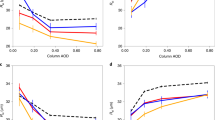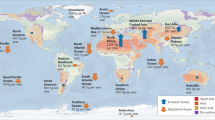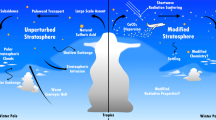Abstract
Aerosol particles can interact with water vapour in the atmosphere, facilitating the condensation of water and the formation of clouds. At temperatures below 273 K, a fraction of atmospheric particles act as sites for ice-crystal formation. Atmospheric ice crystals—which are incorporated into clouds that cover more than a third of the globe1—are thought to initiate most of the terrestrial precipitation2. Before the switch to unleaded fuel last century, the atmosphere contained substantial quantities of particulate lead; whether this influenced ice-crystal formation is not clear. Here, we combine field observations of ice-crystal residues with laboratory measurements of artificial clouds, to show that anthropogenic lead-containing particles are among the most efficient ice-forming substances commonly found in the atmosphere3. Using a global climate model, we estimate that up to 0.8 W m−2 more long-wave radiation is emitted when 100% of ice-forming particles contain lead, compared with when no particles contain lead. We suggest that post-industrial emissions of particulate lead may have offset a proportion of the warming attributed to greenhouse gases.
This is a preview of subscription content, access via your institution
Access options
Subscribe to this journal
Receive 12 print issues and online access
$259.00 per year
only $21.58 per issue
Buy this article
- Purchase on Springer Link
- Instant access to full article PDF
Prices may be subject to local taxes which are calculated during checkout




Similar content being viewed by others
References
Wylie, D. P. & Menzel, W. P. Eight years of high cloud statistics using HIRS. J. Clim. 12, 190–184 (1999).
Lohmann, U. et al. Cloud microphysics and aerosol indirect effects in the global climate model ECHAM5-HAM. Atmos. Chem. Phys. 7, 3425–3446 (2007).
Murphy, D. M. et al. Distribution of lead in single atmospheric particles. Atmos. Chem. Phys. 7, 3763–3804 (2007).
Solomon, S. et al. (eds) Climate Change 2007: The Physical Science Basis. Contribution of Working Group I to the Fourth Assessment Report of the IPCC (Cambridge Univ. Press, 2007).
Liepert, B. G. Observed reductions of surface solar radiation at sites in the United States and worldwide from 1961 to 1990. Geophys. Res. Lett. 29, 61.1–61.4 (2002).
Yau, M. K. & Rogers, R. R. Short Course in Cloud Physics 3rd edn (Butterworth-Heinemann, 1996).
Liou, K.-N. Influence of cirrus clouds on weather and climate processes: A global perspective. Mon. Weath. Rev. 114, 1167–1199 (1986).
Lohmann, U. A glaciation indirect aerosol effect caused by soot aerosols. Geophys. Res. Lett. 29, 11.1–11.4 (2002).
DeMott, P. J. in Cirrus (eds Lynch, D. K., Sassen, K., Starr, D. C. & Stephens, G.) 102–135 (Oxford Univ. Press, 2002).
Pruppacher, H. R. & Klett, J. D. Microphysics of Clouds and Precipitation 2nd edn (Kluwer, 1997).
Archuleta, C. M., DeMott, P. J. & Kreidenweis, S. M. Ice nucleation by surrogates for atmospheric mineral dust and mineral dust/sulfate particles at cirrus temperatures. Atmos. Chem. Phys. 5, 2617–2634 (2005).
Möhler, O., DeMott, P. J., Vali, G. & Levin, Z. Microbiology and atmospheric processes: The role of biological particles in cloud physics. Biogeosciences 4, 1059–1071 (2007).
DeMott, P. J. et al. Measurements of the concentration and composition of nuclei for cirrus formation. Proc. Natl Acad. Sci. 100, 14655–14660 (2003).
Borys, R. D. & Duce, R. A. Relationships among lead, iodine, trace metals and ice nuclei in a coastal urban atmosphere. J. Appl. Meteorol. 18, 1490–1494 (1979).
Möhler, O. et al. Efficiency of the deposition mode ice nucleation on mineral dust particles. Atmos. Chem. Phys. 6, 3007–3021 (2006).
Boutron, C. F. & Patterson, C. C. Lead concentration changes in Antarctic ice during the Wisconsin/Holocene transition. Nature 323, 222–225 (1986).
Environmental Protection Agency. Latest findings on National Air Quality, 2002 Status and Trends (US Environmental Protection Agency, 2003); available at <http://www.epa.gov/air/airtrends/aqtrnd02/2002_airtrends_final.pdf>.
Vonnegut, B. The nucleation of ice formation by silver iodide. J. Appl. Phys. 18, 593–595 (1947).
Schaefer, V. J. Silver and lead iodides as ice-crystal nuclei. J. Meteorol. 11, 417–419 (1954).
Reischel, M. T. Lead nuclei from reactions involving lead, ammonia, and iodine. Atmos. Environ. 9, 955–958 (1975).
Baklanov, A. M. et al. The influence of lead iodide aerosol dispersity on its ice-forming activity. J. Aerosol. Sci. 22, 9–14 (1991).
Lohmann, U., Spichtinger, P., Jess, S., Peter, T. & Smit, H. Cirrus cloud formation and ice supersaturated regions in a global climate model. Environ. Res. Lett. 3, 045022 (2008).
Stier, P. et al. The aerosol-climate model ECHAM5-HAM. Atmos. Chem. Phys. 5, 1125–1156 (2005).
Stetzer, O., Bascheck, B., Lüönd, F. & Lohmann, U. The Zurich ice nucleation chamber (ZINC)—a new instrument to investigate atmospheric ice formation. Aerosol. Sci. Technol. 42, 64–74 (2008).
Ogren, J. A., Heintzenberg, J. & Charlson, R. J. In situ sampling of clouds with a droplet to aerosol converter. Geophys. Res. Lett. 12, 121–124 (1985).
Mertes, S. et al. Counterflow virtual impactor based collection of small ice particles in mixed-phase clouds for the physico-chemical characterization of tropospheric ice nuclei: Sampler description and first case study. Aerosol. Sci. Technol. 41, 848–864 (2007).
Möhler, O. et al. Experimental investigation of homogenous freezing of sulphuric acid particles in the aerosol chamber AIDA. Atmos. Chem. Phys. 3, 211–223 (2003).
Gallavardin, S. J. et al. Single particle laser mass spectrometry applied to differential ice nucleation experiments at the AIDA chamber. Aerosol. Sci. Technol. 42, 773–791 (2008).
Murphy, D. M. The design of single particle laser mass spectrometers. Mass Spectrom. Rev. 26, 150–165 (2007).
Zimmermann, F., Ebert, M., Worringen, A., Schütz, L. & Weinbruch, S. Environmental scanning electron microscopy (ESEM) as a new technique to determine the ice nucleation capability of individual atmospheric aerosol particles. Atmos. Environ. 41, 8219–8227 (2007).
Acknowledgements
We thank P. J. DeMott, D. M. Murphy and D. S. Thomson for their assistance with the measurements. We also acknowledge the effort of all of the participants of the INSPECT and CLACE field studies, the support of the High Altitude Research Foundation Gornergrat and Jungfraujoch and the experimental group at AIDA. This research was supported by the Atmospheric Composition Change the European Network for Excellence, ETH Zurich, the German Research Foundation and Pacific Northwest National Laboratory directed research funding.
Author information
Authors and Affiliations
Contributions
D.J.C., single-particle mass spectrometry, data analysis and paper writing; O.S., ice nucleation experiments and data analysis; A.W., M.E. and S.W., sample acquisition, electron microscopy and data interpretation and analysis; M.K., S.J.G., J.C. and S.B., mass spectrometer development, sample acquisition for single-particle mass spectrometry and data analysis; S.M., ice crystal sample acquisition and data analysis; O.M. and K.D.F., conducted AIDA experiments and data analysis; U.L., GCM programming and data analysis.
Corresponding author
Supplementary information
Supplementary Information
Supplementary Information (PDF 336 kb)
Rights and permissions
About this article
Cite this article
Cziczo, D., Stetzer, O., Worringen, A. et al. Inadvertent climate modification due to anthropogenic lead. Nature Geosci 2, 333–336 (2009). https://doi.org/10.1038/ngeo499
Received:
Accepted:
Published:
Issue Date:
DOI: https://doi.org/10.1038/ngeo499
This article is cited by
-
Assessment of Airborne Lead Provenance in Northern Ontario, Canada, Using Isotopic Ratios in Snow and Cladonia rangiferina Lichens
Water, Air, & Soil Pollution (2021)
-
Ice nucleation by aerosols from anthropogenic pollution
Nature Geoscience (2019)



